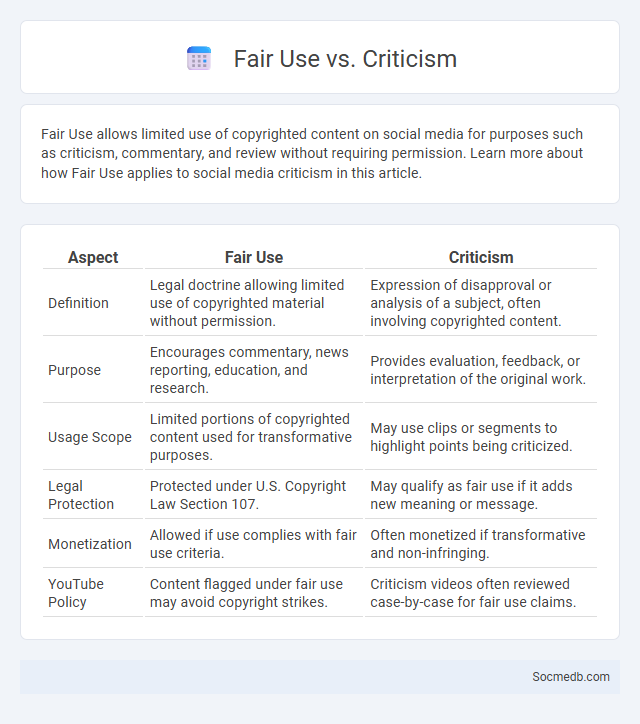
Photo illustration: Fair Use vs Criticism
Fair Use allows limited use of copyrighted content on social media for purposes such as criticism, commentary, and review without requiring permission. Learn more about how Fair Use applies to social media criticism in this article.
Table of Comparison
| Aspect | Fair Use | Criticism |
|---|---|---|
| Definition | Legal doctrine allowing limited use of copyrighted material without permission. | Expression of disapproval or analysis of a subject, often involving copyrighted content. |
| Purpose | Encourages commentary, news reporting, education, and research. | Provides evaluation, feedback, or interpretation of the original work. |
| Usage Scope | Limited portions of copyrighted content used for transformative purposes. | May use clips or segments to highlight points being criticized. |
| Legal Protection | Protected under U.S. Copyright Law Section 107. | May qualify as fair use if it adds new meaning or message. |
| Monetization | Allowed if use complies with fair use criteria. | Often monetized if transformative and non-infringing. |
| YouTube Policy | Content flagged under fair use may avoid copyright strikes. | Criticism videos often reviewed case-by-case for fair use claims. |
Understanding the Concept of Fair Use
Fair use in social media refers to the limited use of copyrighted content without permission for purposes such as commentary, criticism, news reporting, education, or parody. Key factors determining fair use include the purpose and character of the use, the nature of the copyrighted work, the amount used, and the effect on the work's market value. Understanding fair use is essential for content creators to avoid legal issues while fostering creativity and sharing information.
What Constitutes Criticism in Copyright Law
Criticism in copyright law is defined as the fair use of copyrighted material to analyze, comment on, or evaluate the original work, often for the purpose of review or scholarly discussion. It must involve transformation or adding new meaning or message, rather than mere replication of the original content, ensuring that the economic value of the original work is not harmed. Social media platforms frequently host such critical content, where users provide reviews, parodies, or commentary that help qualify as protected criticism under fair use doctrines.
Key Differences Between Fair Use and Criticism
Fair use allows you to use copyrighted content without permission under specific circumstances like commentary, criticism, or educational purposes, focusing on how much and what type of content is used. Criticism specifically involves evaluating or analyzing a work, often relying on fair use protections to legally quote or display parts of the original material. Understanding these distinctions is crucial for social media users to avoid copyright infringement while expressing opinions or reviews.
Core Principles Governing Fair Use
The core principles governing fair use in social media emphasize the purpose and character of the use, including whether it is transformative or commercial. Courts also consider the nature of the copyrighted work, the amount and substantiality of the portion used, and the effect of the use on the potential market value. Applying these principles ensures balanced protection for original creators while allowing reasonable content sharing and commentary across social platforms.
Types of Works Commonly Involved in Fair Use
Fair use in social media commonly involves works such as user-generated content, memes, commentary videos, and parody. These types of works often include excerpts from copyrighted materials like music, film clips, or images used for critique, education, or satire. Understanding the specific nature of transformative use and the amount of content utilized is crucial for determining fair use applicability in these contexts.
Legal Criteria for Fair Use Evaluation
Legal criteria for fair use evaluation in social media primarily involve assessing the purpose and character of the use, including whether it is of a commercial nature or for nonprofit educational purposes. Courts also consider the nature of the copyrighted work, the amount and substantiality of the portion used, and the effect of the use on the potential market for or value of the original work. These factors collectively determine whether social media content sharing qualifies as fair use under copyright law, influencing content moderation and user-generated content policies.
Case Studies: Fair Use vs Criticism in Court
Case studies involving social media frequently highlight the complex balance between fair use and criticism in court rulings, illustrating how courts interpret copyright laws in digital contexts. Notable cases such as Campbell v. Acuff-Rose Music have set precedents by emphasizing transformative use and the purpose of criticism in determining fair use defenses. These rulings underscore the importance of context, intent, and the nature of the content in assessing whether social media criticism qualifies as legally protected fair use.
Limitations and Exceptions of Fair Use
Social media platforms present unique challenges to Fair Use due to the vast amount of user-generated content and varied copyright enforcement policies. Limitations include the potential for copyright holders to issue takedown notices, while exceptions may apply for commentary, criticism, or transformative use under Fair Use law. Understanding these boundaries helps you navigate content sharing legally and protect your rights on social platforms.
Navigating Copyright Risks in Criticism
Navigating copyright risks in social media criticism requires a clear understanding of fair use policies and the limitations on reproducing copyrighted content. Critics must ensure their commentary adds transformative value, such as analysis or parody, to avoid infringement claims. Employing strategies like proper attribution and using minimal copyrighted material enhances legal protection while maintaining impactful social media engagement.
Best Practices for Creators on Fair Use and Criticism
Creators on social media must understand fair use principles to legally incorporate copyrighted material, emphasizing transformative content and non-commercial purposes. Criticism should be clearly stated as commentary or analysis to avoid infringement, supporting free expression while respecting original creators' rights. Proper attribution and avoiding excessive use of protected content further safeguard creators against legal challenges.
 socmedb.com
socmedb.com